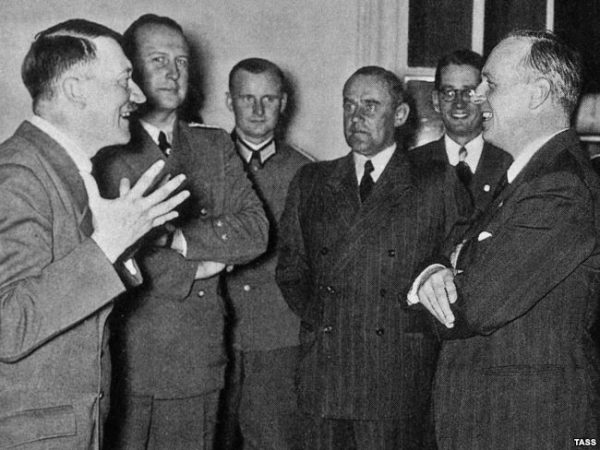Tom Metzger’s WAR (White Aryan Resistance) was always the archetypal Nazi skinhead group. Their newspaper was filled with crass cartoons of Jews and African-Americans (picture big noses and big lips,) but it was his cable-access TV show, Race and Reason, that was most popular with the neo-Nazi skinheads in the Deep South community I grew up in.
As I understood WAR at the tail end of the 1980s, they sought to instigate a violent revolution, and their vanguard was going to be the Nazi skinhead movement—resurrected brownshirts. Sporting Adolf Hitler tattoos, these skinheads were rather unreflective about the fate of the actual brownshirt leaders.
Much later, I learned that Metzger was one of the few racist leaders who had seriously courted the rising Nazi skinhead movement in the mid-1980s. Most organized racists, including his fellow National Socialists, were cultural conservatives—for some reason, many neo-Nazi professionals are dentists—and looked down on the skinheads. But Metzger only saw potential, and successfully recruited them while simultaneously promoting himself as a leader.
Some of this came through WAR’s alliance with the American Front, the first important national racist skinhead group; led by Bob Heick, they had held a White Workers Day march on May 1, 1988 in San Francisco, and were closely associated with industrial musician Boyd Rice. In 1989, WAR and American Front worked together to put on an “Aryan Woodstock” gathering. The two groups were different than many American racists because of their Third Position politics—that is, a kind of fascism that is anti-capitalist (but opposed to the Left), racial separatist (sometimes allying with non-white racial separatists), and, more recently, environmentalist. In Gods of the Blood: The Pagan Revival and White Separatism, Matthias Gardell, describes Metzger’s economic views as such:
Inspired by Jack London and populist icons Huey Long and Father Coughlin, Metzger construed an Americanized version of the “third position,” which advanced national socialism as an alternative to communism and capitalism, “neither left, nor right, but forward,” as with the left-leaning, national socialist continuation of Strasserite national socialism and the leftist tendency of early Italian fascism. While admiring Hitler, Metzger recognized as glaring errors the Night of the Long Knifes—the 1934 purge in the NSDAP the of leftist and National-Bolshevik elements—and the overturn of the Molotov-Ribbentrop Pact—a non-aggression pact signed in 1939 between Germany and the Soviet Union and broken by Germany in 1941. Metzger believed that in suppressing the socialist wing of the NSDAP, Hitler had “stuck the wrong pig” and moved toward an alliance with capitalism. Had Hitler not attacked Soviet Russia, Metzger believed, the war might have ended differently and Soviet Russia would have developed a National Bolshevik ideology. From Metzger’s third-positionist point of view, revolutionary racism “can’t move much further with the right-wing in our way,” Metzger claimed. “Just as it was in our way in [national socialist] Germany, the right wing slows us down.” The “main problem” of today is that “transnational corporations…now virtually runs the world,” Metzger said. “All of the racial problems are a side issue that comes from economic problems caused by multinational corporations.”
Metzger differs from many other [white separatist] counterculture ideologues in not using global capitalism as an anti-Semitic euphemism. “I don’t take the extreme position and say that the Jews run everything, because they don’t. Take the 400 most important multinational corporations and you got your structure for the global government…and Jews are just a small faction of it.” While finding race to be an agitating issue—and seeking to fan the flames by using vulgar racist rhetoric in WAR—Metzger foresees a revolution sprung from conflicts generated by the world capitalist system. “As the rich are getting richer and the poor are getting poorer, and the massive influx of people from other nations, mostly nonwhite, and the exporting of more and more jobs from this country, you know, the chemistry is there, it’s like a bomb, waiting for someone to light the fuse.” The violent cleansing deemed necessary will, Metzger reasoned, most likely be triggered by riots in depressed black and Hispanic inner cities, wreaking havoc, which white revolutionaries will capitalize on. The future Aryan homeland will guarantee “free education,” “free medical and health care,” ecologically sustainable production, and “economic justice.” “Major white collar criminals would be publicly executed, so that poor people realize that justice is for everybody.” Moving units of production overseas will be banned and military intervention in foreign wars will cease. The border will be permanently sealed. Millions of non-Aryan immigrants will be deported by force, and negotiations with African Americans will set terms for racial separatism by “repatriation” or territorial division.
In his heyday, Tom Metzger took pains to reach out to the Left, and he had some success. WAR roped in Gary/John Jewell, a former member of the Industrial Workers of the World (IWW) who had served on one of the union’s national committees, as well as Wyatt Kaldenberg, a former Trotskyist who became the editor of the WAR newspaper. Metzger also claimed to have made inroads with Earth First! (although he never showed evidence of this being true.)

Today, Tom Metzger continues this outreach. For example, in 2010 a participant at the Anti-Racist Action conference handed me a printout of a note Metzger had sent to an anarchist group in Phoenix, Arizona. It included Metzger’s current (and toned-down) ten-point program, which stressed a hatred of global capitalism and concern for the environment, and advocated eliminating corporate personhood, making the remaining American colonies and territories independent, and rebuilding infrastructure—as well as ending immigration, letting the 50 states “regain their individual sovereignty,” and revitalizing the Articles of Confederation. (There was nothing about repatriation of non-whites or creating an “Aryan homeland.”)
Metzger said he agreed with the group that “the system of white supremacy is a cross-class alliance between rich whites and working class whites,” the purpose of which was to maintain capitalism. He quoted the anti-Semite Hervé Ryssen (“The greedy and corrupt Right Wing / drives the Working Class to the Left / where Marxists scoop them up!”) before concluding: “We struggle for Left Wing racial separatism, and are Not supremacists. You probably don’t agree with All of Our Positions, but I bet we agree on most of them!”
Metzger never got more than a few cross-recruits from the Left; clearly the skinheads were his real constituency. However, the ideology of a political leader and that of his followers are not always the same. The economics of the Nazi skinheads that I remember were always vague. On one hand, they hated “communists” (and socialists, anarchists, liberals—as well as gay folks, people of color, and Jews—and not to mention their teachers, the police, Hollywood…so, really, pretty much everyone if you think about it.) On the other, you rarely saw free-market rhetoric bandied about, as you do today among racist agorists and anarcho-capitalists.

The various countercultures (at the time mostly punk, hippie, goth, and skinhead,) despite their differences, generally agreed on a few things: not working, cheap rent, a distinct fashion, music and art, drugs and alcohol, and a distrust of the institutional pillars of the system, including large economic interests—even if this economic view was more instinctual than any kind of a particular thought-out position. If there was one thing counter-culturalists could agree on, it might have been that we all hated businessmen. So, while there wasn’t necessarily a lot of heavy anti-capitalist rhetoric among the Nazi skinheads that I remember, it’s not surprising that it was a Third Positionist who was the one able to successfully reach out to them in the United States.
Lest I overstate my case here, there were others promoting Third Position and similar ideology in the same racist waters that Tom Metzger swam in. The National Front, the British party that the original Nazi skinheads were mostly affiliated with, was heavily influenced by Third Positionism around that time—having been introduced to it by Italians fleeing indictments for a mass-casualty bombing. They, in turn, were largely inspired by the Italian fascist philosopher Julius Evola, who is currently experiencing a revival in the more intellectual Far Right circles. Metzger’s rival, Willis Carto, was a populist who was also critical of contemporary capitalism, having been influenced by Francis Parker Yockey, whose work in turn presaged the New Right and Third Position developments in the fascist movement. And of course Third Positionism was not the only ideology influential on the neo-Nazi skinheads; they looked up to groups like the Aryan Nations, and where I am from, were also courted by the more conventionally racist Ed Fields, a locally based third-tier personality in the white nationalist world.
Metzger is still around, living in the house his mother left to him in Warsaw, Indiana (a famous SPLC civil suit, holding him liable for the death of an Ethiopian immigrant who was murdered by neo-Nazi skinheads, bankrupted Metzger.) He continues to write and appear on white nationalist Internet radio. (His appearance over a decade ago in Louis Theroux’s unkind documentary Louis and the Nazis is probably the most mainstream media attention Metzger has received in years.)
Tom Metzger’s influence in spreading Third Position ideas throughout the American Nazi skinhead and related white separatist movements can be seen today, as former Nazi skinheads have developed these ideas into new, post-Third Positionist directions. Taking reciprocal racial separatism, anti-capitalism, ecology, and outreach to the Left more seriously than their predecessors did, they have combined these notions (along with the influence of the New Right’s Alain de Benoist and Alexander Dugin) with an array of perspectives.
Hence today, we see a former leader of the American Front denouncing capitalism while supporting Dugin under the banner of the “Fourth Position.” Meanwhile, other former countercultural neo-Nazis created National Anarchism, which was designed as a kind of Third Position fascism with a greater level of decentralization. (The precursor group to the National Anarchists, the National Revolutionary Faction, was in a Third Position international with the American Front—surprise, surprise.) In 1988, Metzger had declared: “WAR believes that if it works, use it. If it doesn’t, try something else.” I would guess that Metzger—who donated money to the Nation of Islam and addressed the New Black Panther Party—looks with some mix of envy and admiration on these new developments.
Metzger’s moment has passed, but his legacy in spreading Third Positionism throughout America’s racist counterculture remains.
Photographs courtesy of Joel Schalit





